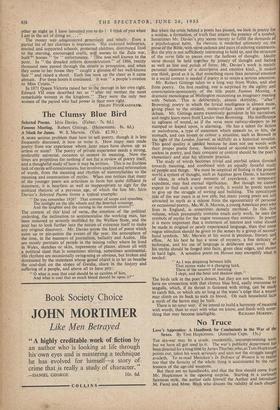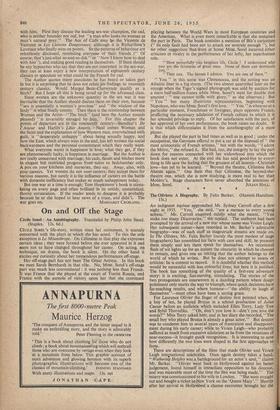No Truce
Love's Apprentice: A Handbook for Combatants in the War of the Sexes. By Tom Hopkinson. (Jonathan Cape. 15s.) THE sex-war may be a crude, unscientific, uncompromising tern'', but we have all got used to it. The war's publicity department has been directed for a long time by James Thurber, who, as Tom Hopkinson points out, takes his work seriously and says not the struggle naught availeth. To re-read Mencken's In Defence of Women is to realise too that the ferocity of the whole thing is accentuated by the rust' lessness of the age-old weapons.
But there are no handbooks, and that the first should come front Mr. Hopkinson is the opening surprise. Starting in a curiously facetious style, the author calls himself the Author and introduces M. Fiend and Mme. Bitch who discuss the validity of each chapter with him. First they discuss the leading sex-war champion, the cad, who is neither bounder nor oaf, but "a man who looks on woman as man's natural prey." The Ace of Cads may be the Vicomte de Valmont in Les Liaisons Dangereuses, although it is Richardson's Lovelace who finally wins on points. So the patterns of behaviour are relentlessly disclosed, reminding everyone of their friends (" Of course, that's just what so-and-so did," or "Now 1 know how to deal with him"), and malting good reading in themselves. If there should be any hypocrites who say that they are not interested in the sex-war, they can at least enjoy a new interpretation of eighteenth century classics or speculate on what could be the French for cad.
The Author quotes many anecdotes he has heard or taken part in but it is surprising that he does not relate his findings to twentieth century classics. Would Margot Beste-Chetwynde qualify as a bitch? But I hope all this is being saved up for the advanced class.
Since women are the unknown quantity in the sex war it was inevitable that the Author should discuss them on their own, because "sex is essentially a woman's province" and "the wisdom of the body" is what finally counts. Then there is the relationship between Woman and the Artist—"The bitch" (and here the Author sounds pleased) "is invariably enraged by him." For this chapter the points of departure are in the nineteenth century—Stendhal's De 1 'Amour and Hazlitt's Liber Amoris. Next comes Woman and the Saint and the explanation of how Western man, overwhelmed with guilt, is "desperately unhappy" about being sexually happy, and how the East, which always wins in the end, has left women the social backwardness and the personal contentment which they really want.
What everyone wants is happiness in love; what they get, if they are phenomenally lucky, is happiness in marriage. But the Author is not really concerned with marriage; his cads, fiends and bitches move in elegant but restricted progress from salon to bedchamber only. A pox on your kitchens and nurseries, they say. Away, also, with your careers. Yet women do not want careers; they accept them for various reasons, but surely it is the influence of careers on the battle with domestic inefficiency that makes so much unhappiness today.
But one war at a time is enough; Tom Hopkinson's book is stimu- lating on every page and often brilliant in its untidy, unstatistical, thorny coruscation. If the reader tends to disagree it is probably because he or she hoped to hear news of a truce, and didn't. The



































 Previous page
Previous page